Ricoh MP C2003, MP C2503 User Manual

User Guide
What You Can Do with This Machine
Getting Started
Copy
Fax
Scan
Document Server
Web Image Monitor
Adding Paper and Toner
Troubleshooting
For information not in this manual, refer to the HTML/PDF files on the supplied
CD-ROM.
For safe and correct use, be sure to read the Safety Information in "Read This First" before using the machine.
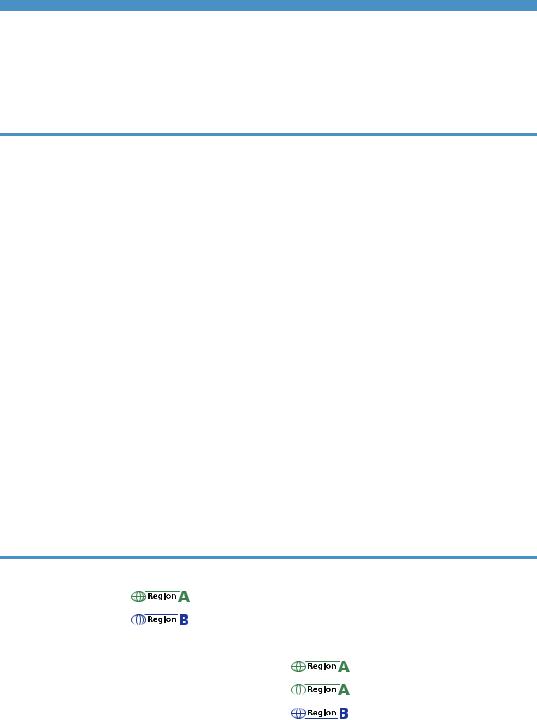
TABLE OF CONTENTS |
|
|
|
How to Read the Manuals................................................................................................................................. |
|
|
6 |
Symbols Used in the Manuals....................................................................................................................... |
|
|
6 |
Model-Specific Information............................................................................................................................... |
|
|
7 |
Names of Major Features.................................................................................................................................. |
|
|
8 |
1. What You Can Do with This Machine |
|
|
|
Reducing my Costs............................................................................................................................................. |
|
|
9 |
Converting Documents to Electronic Formats Easily...................................................................................... |
|
10 |
|
Registering Destinations................................................................................................................................... |
|
|
11 |
Operating the Machine More Effectively...................................................................................................... |
|
12 |
|
Customizing the [Home] Screen..................................................................................................................... |
|
|
13 |
Making Copies Using Various Functions........................................................................................................ |
|
14 |
|
Printing Data Using Various Functions............................................................................................................ |
|
16 |
|
Utilizing Stored Documents............................................................................................................................. |
|
|
17 |
Sending and Receiving Faxes without Paper................................................................................................. |
|
18 |
|
Sending and Receiving Faxes via the Internet............................................................................................... |
|
20 |
|
Sending and Receiving Faxes by Using the Machine without Fax Unit Installed....................................... |
22 |
||
Using the Facsimile and the Scanner in a Network Environment................................................................. |
|
23 |
|
Embedding Text Information in Scanned Files............................................................................................... |
|
24 |
|
Preventing Information Leakage (Security Functions).................................................................................... |
|
25 |
|
Centrally Controlling Scan Conditions and Distribution............................................................................... |
|
26 |
|
Monitoring and Setting the Machine Using a Computer.............................................................................. |
|
27 |
|
Preventing Unauthorized Copying................................................................................................................. |
|
|
28 |
2. Getting Started |
|
|
|
Guide to Names and Functions of Components............................................................................................ |
|
29 |
|
Guide to Components |
(mainly Europe and Asia)................................................................. |
|
29 |
Guide to Components |
(mainly North America).................................................................... |
|
32 |
Guide to Functions of the Machine's Options................................................................................................ |
|
36 |
|
Guide to Functions of the Machine's External Options |
(mainly Europe)............................ |
36 |
|
Guide to Functions of the Machine's External Options |
(mainly Asia)................................. |
37 |
|
Guide to Functions of the Machine's External Options |
(mainly North America)................ |
39 |
|
Guide to the Names and Functions of the Machine's Control Panel (When Using the Standard |
|||
Operation Panel).............................................................................................................................................. |
|
|
41 |
1
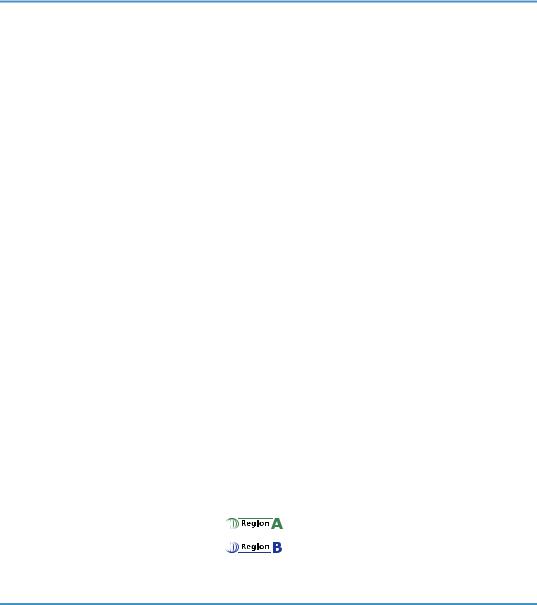
Guide to the Names and Functions of the Machine's Control Panel (When Using the Smart Operation |
||
Panel)................................................................................................................................................................ |
|
44 |
Changing the Display Language.................................................................................................................... |
|
46 |
Changing the Display Language (When Using the Smart Operation Panel)......................................... |
46 |
|
How to Use the [Home] Screen (When Using the Standard Operation Panel)......................................... |
47 |
|
Adding Icons to the [Home] Screen (When Using the Standard Operation Panel).............................. |
48 |
|
How to Use the [Home] Screen (When Using the Smart Operation Panel)............................................... |
52 |
|
Adding Icons to the [Home] Screen (When Using the Smart Operation Panel).................................... |
53 |
|
Registering Functions in a Program................................................................................................................. |
|
57 |
Example of Programs................................................................................................................................... |
|
60 |
Turning On/Off the Power.............................................................................................................................. |
|
63 |
Turning On the Main Power........................................................................................................................ |
|
63 |
Turning Off the Main Power........................................................................................................................ |
|
63 |
When the Authentication Screen is Displayed............................................................................................... |
|
64 |
User Code Authentication Using the Control Panel.................................................................................. |
|
64 |
Logging In Using the Control Panel (When Using the Standard Operation Panel)............................... |
64 |
|
Logging In Using the Control Panel (When Using the Smart Operation Panel)..................................... |
65 |
|
Logging Out Using the Control Panel (When Using the Standard Operation Panel)............................ |
66 |
|
Logging Out Using the Control Panel (When Using the Smart Operation Panel).................................. |
66 |
|
Placing Originals.............................................................................................................................................. |
|
67 |
Placing Originals on the Exposure Glass |
(mainly Europe and Asia).................................. |
67 |
Placing Originals on the Exposure Glass |
(mainly North America)...................................... |
67 |
Placing Originals in the Auto Document Feeder....................................................................................... |
|
68 |
3. Copy |
|
|
Basic Procedure................................................................................................................................................ |
|
71 |
Auto Reduce / Enlarge.................................................................................................................................... |
|
73 |
Duplex Copying............................................................................................................................................... |
|
75 |
Specifying the Original and Copy Orientation......................................................................................... |
|
77 |
Combined Copying......................................................................................................................................... |
|
79 |
One-Sided Combine................................................................................................................................... |
|
80 |
Two-Sided Combine.................................................................................................................................... |
|
81 |
Copying onto Custom Size Paper from the Bypass Tray.............................................................................. |
|
84 |
Copying onto Envelopes................................................................................................................................. |
|
85 |
2

Copying onto Envelopes from the Bypass Tray......................................................................................... |
85 |
Copying onto Envelopes from the Paper Tray........................................................................................... |
86 |
Sort.................................................................................................................................................................... |
87 |
Changing the Number of Sets.................................................................................................................... |
88 |
Storing Data in the Document Server............................................................................................................. |
90 |
4. Fax |
|
Basic Procedure for Transmissions (Memory Transmission).......................................................................... |
91 |
Sending Originals Using the Exposure Glass (Memory Transmission)................................................... |
93 |
Registering a Fax Destination...................................................................................................................... |
94 |
Deleting a Fax Destination.......................................................................................................................... |
95 |
Transmitting while Checking Connection to Destination (Immediate Transmission)................................... |
97 |
Sending Originals Using the Exposure Glass (Immediate Transmission)................................................ |
98 |
Canceling a Transmission............................................................................................................................. |
100 |
Canceling a Transmission Before the Original Is Scanned.................................................................... |
100 |
Canceling a Transmission While the Original Is Being Scanned.......................................................... |
100 |
Canceling a Transmission After the Original Is Scanned....................................................................... |
101 |
Storing a Document....................................................................................................................................... |
103 |
Sending Stored Documents...................................................................................................................... |
104 |
Printing the Journal Manually....................................................................................................................... |
106 |
5. Print |
|
Quick Install.................................................................................................................................................... |
107 |
Displaying the Printer Driver Properties........................................................................................................ |
108 |
Standard Printing........................................................................................................................................... |
109 |
When Using the PCL 6 Printer Driver....................................................................................................... |
109 |
Printing on Both Sides of Sheets................................................................................................................... |
110 |
When Using the PCL 6 Printer Driver....................................................................................................... |
110 |
Types of 2 sided Printing........................................................................................................................... |
110 |
Combining Multiple Pages into Single Page............................................................................................... |
111 |
When Using the PCL 6 Printer Driver....................................................................................................... |
111 |
Types of Combine Printing........................................................................................................................ |
111 |
Printing on Envelopes.................................................................................................................................... |
113 |
Configuring Envelope Settings Using the Control Panel........................................................................ |
113 |
Printing on Envelopes Using the Printer Driver........................................................................................ |
114 |
3
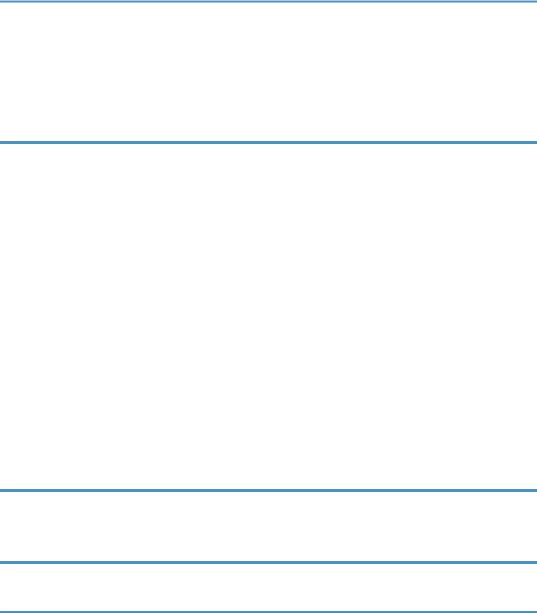
Saving and Printing Using the Document Server......................................................................................... |
115 |
Storing Documents in Document Server.................................................................................................. |
115 |
Managing Documents Stored in Document Server................................................................................ |
116 |
6. Scan |
|
Basic Procedure When Using Scan to Folder............................................................................................. |
117 |
Creating a Shared Folder on a Computer Running Windows/Confirming a Computer's Information..... |
|
.................................................................................................................................................................... |
118 |
Registering an SMB Folder....................................................................................................................... |
120 |
Deleting an SMB Registered Folder......................................................................................................... |
124 |
Entering the Path to the Destination Manually........................................................................................ |
125 |
Basic Procedure for Sending Scan Files by E-mail...................................................................................... |
126 |
Registering an E-mail Destination............................................................................................................. |
127 |
Deleting an E-mail Destination................................................................................................................. |
129 |
Entering an E-mail Address Manually..................................................................................................... |
130 |
Basic Procedure for Storing Scan Files........................................................................................................ |
131 |
Checking a Stored File Selected from the List......................................................................................... |
132 |
Specifying the File Type................................................................................................................................ |
134 |
Specifying Scan Settings............................................................................................................................... |
135 |
7. Document Server |
|
Storing Data................................................................................................................................................... |
137 |
Printing Stored Documents............................................................................................................................ |
139 |
8. Web Image Monitor |
|
Displaying Top Page..................................................................................................................................... |
141 |
9. Adding Paper and Toner |
|
Precautions for Loading Paper...................................................................................................................... |
143 |
Loading Paper into Paper Trays................................................................................................................... |
144 |
Loading Paper into the Bypass Tray............................................................................................................. |
146 |
Printing from the Bypass Tray Using the Printer Function........................................................................ |
147 |
Loading Orientation-fixed Paper or Two-sided Paper............................................................................... |
152 |
Recommended Paper Sizes and Types........................................................................................................ |
155 |
Thick Paper................................................................................................................................................. |
162 |
Envelopes................................................................................................................................................... |
163 |
Adding Toner................................................................................................................................................. |
167 |
4

Sending Faxes or Scanned Documents When Toner Has Run Out...................................................... |
169 |
Disposing of Used Toner........................................................................................................................... |
169 |
10. Troubleshooting |
|
When a Status Icon Is Displayed.................................................................................................................. |
171 |
When the Indicator Lamp for the [Check Status] Key Is Lit or Flashing..................................................... |
173 |
When the Machine Makes a Beeping Sound............................................................................................. |
175 |
When You Have Problems Operating the Machine................................................................................... |
176 |
When Multiple Functions Cannot Be Executed Simultaneously............................................................ |
181 |
Messages Displayed When Using the Copy/Document Server Function................................................ |
182 |
Messages Displayed When Using the Facsimile Function......................................................................... |
186 |
When There Is a Problem Specifying the Network Settings.................................................................. |
187 |
When the Remote Fax Function Cannot Be Used................................................................................... |
193 |
Messages Displayed When Using the Printer Function.............................................................................. |
196 |
Messages Displayed on the Control Panel When Using the Printer Function...................................... |
196 |
Messages Printed on the Error Logs or Reports When Using the Printer Function............................... |
199 |
Messages Displayed When Using the Scanner Function........................................................................... |
209 |
Messages Displayed on the Control Panel When Using the Scanner Function................................... |
209 |
Messages Displayed on the Client Computer......................................................................................... |
218 |
When Other Messages Appear................................................................................................................... |
225 |
When There Is a Problem Scanning or Storing Originals...................................................................... |
226 |
When the Home Screen Cannot Be Edited (When Using the Standard Operation Panel)................ |
227 |
When the Address Book Is Updated....................................................................................................... |
228 |
When Data Cannot Be Sent Due to a Problem with the Destination..................................................... |
229 |
When the Machine Cannot Be Operated Due to a Problem with the User Certificate....................... |
229 |
When Problems Occur While Logging In............................................................................................... |
231 |
When the User Lacks Privileges to Perform an Operation..................................................................... |
231 |
When the LDAP Server Cannot Be Used................................................................................................. |
231 |
INDEX........................................................................................................................................................... |
233 |
5

How to Read the Manuals
Symbols Used in the Manuals
This manual uses the following symbols:
Indicates points to pay attention to when using the machine, and explanations of likely causes of paper misfeeds, damage to originals, or loss of data. Be sure to read these explanations.
Indicates supplementary explanations of the machine's functions, and instructions on resolving user errors.
This symbol is located at the end of sections. It indicates where you can find further relevant information.
[ ]
Indicates the names of keys on the machine's display or control panels. 



 (mainly Europe and Asia), (mainly Europe), or (mainly Asia)
(mainly Europe and Asia), (mainly Europe), or (mainly Asia) 



 (mainly North America)
(mainly North America)
Differences in the functions of Region A and Region B models are indicated by two symbols. Read the information indicated by the symbol that corresponds to the region of the model you are using. For details about which symbol corresponds to the model you are using, see page 7 "Model-Specific Information".
6
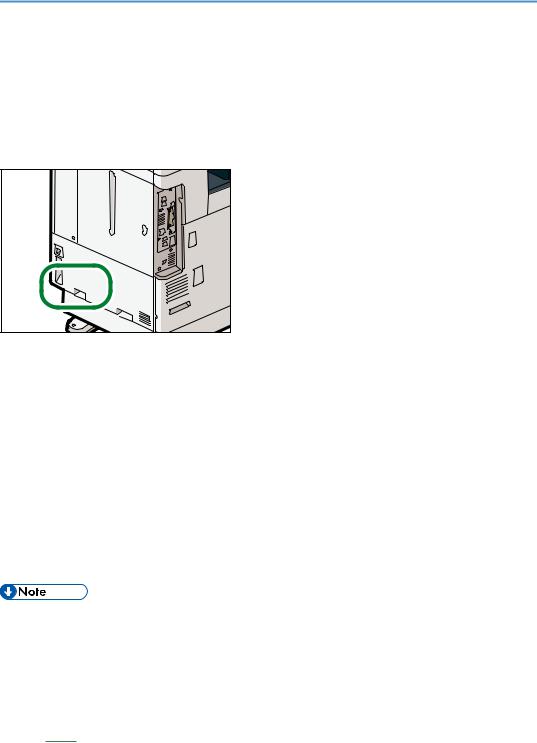
Model-Specific Information
This section explains how you can identify the region your machine belongs to.
There is a label on the rear of the machine, located in the position shown below. The label contains details that identify the region your machine belongs to. Read the label.
DAT014 |
The following information is region-specific. Read the information under the symbol that corresponds to the region of your machine.




 (mainly Europe and Asia)
(mainly Europe and Asia)
If the label contains the following, your machine is a region A model:
•CODE XXXX -25, -27, -29
•220–240 V




 (mainly North America)
(mainly North America)
If the label contains the following, your machine is a region B model:
•CODE XXXX -17, -18
•120–127 V
•Dimensions in this manual are given in two units of measure: metric and inch. If your machine is a Region A model, refer to the metric units. If your machine is a Region B model, refer to the inch units.
•If your machine is a region A model and "CODE XXXX -25, -27" is printed on the label, see "



 (mainly Europe)" also.
(mainly Europe)" also.
•If your machine is a region A model and "CODE XXXX -29" is printed on the label, see "



 (mainly Asia)" also.
(mainly Asia)" also.
7

Names of Major Features
In this manual, major features of the machine are referred to as follows:
• Auto Document Feeder  ADF
ADF
8
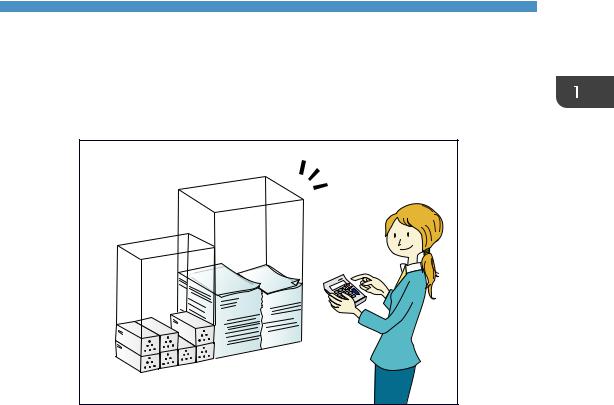
1. What You Can Do with This Machine
You can search for a description by what you want to do.
Reducing my Costs
BRL059S
Printing multi-page documents on both sides of sheets (Duplex Copy)
 See "Duplex Copying", Copy/ Document Server.
See "Duplex Copying", Copy/ Document Server.
Printing multi-page documents and received faxes on a single sheet (Combine (Copier/Fax))
 See "Combined Copying", Copy/ Document Server.
See "Combined Copying", Copy/ Document Server.
 See "Combine Two Originals", Fax.
See "Combine Two Originals", Fax.
Printing received faxes on both sides of sheets (2 Sided Print)
 See "Two-Sided Printing", Fax.
See "Two-Sided Printing", Fax.
Converting received faxes to electronic formats (Paperless Fax)
 See "Confirming/Printing/Deleting Received and Stored Documents", Fax.
See "Confirming/Printing/Deleting Received and Stored Documents", Fax.
Sending files from the computer without printing them (LAN-Fax)
 See "Sending Fax Documents from Computers", Fax.
See "Sending Fax Documents from Computers", Fax.
Checking how much paper is saved ([Information] screen)
 See "How to Use the [Information] Screen", Getting Started.
See "How to Use the [Information] Screen", Getting Started.
Reducing electricity consumption
 See "Saving Energy", Getting Started.
See "Saving Energy", Getting Started.
 See "Timer Settings", Connecting the Machine/ System Settings.
See "Timer Settings", Connecting the Machine/ System Settings.
9
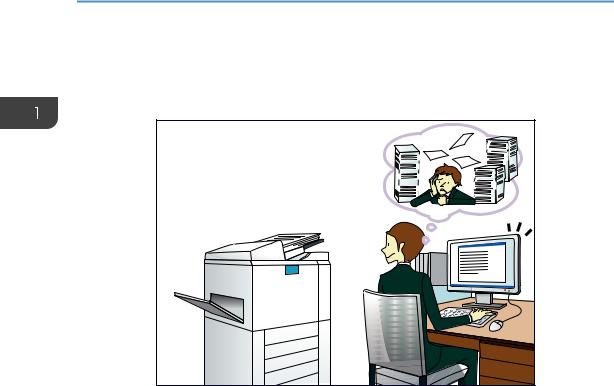
1. What You Can Do with This Machine
Converting Documents to Electronic Formats Easily
BQX138S |
Sending scan files
 See "Basic Procedure for Sending Scan Files by E-mail", Scan.
See "Basic Procedure for Sending Scan Files by E-mail", Scan.
Sending the URL of the folder in which scan files are stored
 See "Sending the URL by E-mail", Scan.
See "Sending the URL by E-mail", Scan.
Storing scan files in a shared folder
 See "Basic Procedure When Using Scan to Folder", Scan.
See "Basic Procedure When Using Scan to Folder", Scan.
Storing scan files on media
 See "Basic Procedure for Saving Scan Files on a Memory Storage Device", Scan.
See "Basic Procedure for Saving Scan Files on a Memory Storage Device", Scan.
Embedding text information in scanned files
 See "Embedding Text Information in Scanned Data", Scan.
See "Embedding Text Information in Scanned Data", Scan.
Converting transmitted faxes to electronic formats and sending them to a computer
 See "Overview of Folder Transmission Function", Fax.
See "Overview of Folder Transmission Function", Fax.
Managing and using documents converted to electronic formats (Document Server)
 See "Relationship between Document Server and Other Functions", Copy/ Document Server.
See "Relationship between Document Server and Other Functions", Copy/ Document Server.
10
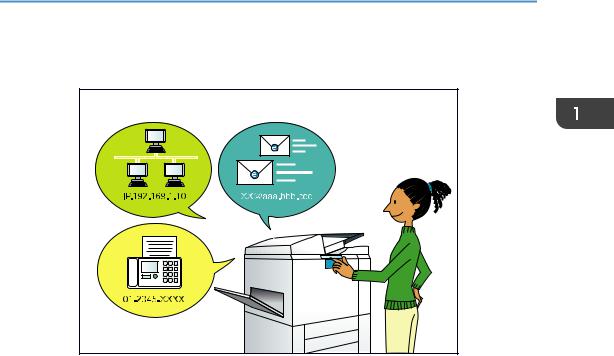
Registering Destinations
Registering Destinations
BRL060S
Using the control panel to register destinations in the Address Book
 See "Registering Entered Destinations to the Address Book", Fax.
See "Registering Entered Destinations to the Address Book", Fax.
 See "Registering a destination in the address book manually", Scan.
See "Registering a destination in the address book manually", Scan.
Using Web Image Monitor to register destinations from a computer
 See "Registering Internet Fax Destination Information Using Web Image Monitor", Fax.
See "Registering Internet Fax Destination Information Using Web Image Monitor", Fax.
Downloading destinations registered in the machine to the LAN-Fax driver destination list
 See "Using the machine's Address Book as the LAN-Fax destination list", Fax.
See "Using the machine's Address Book as the LAN-Fax destination list", Fax.
11
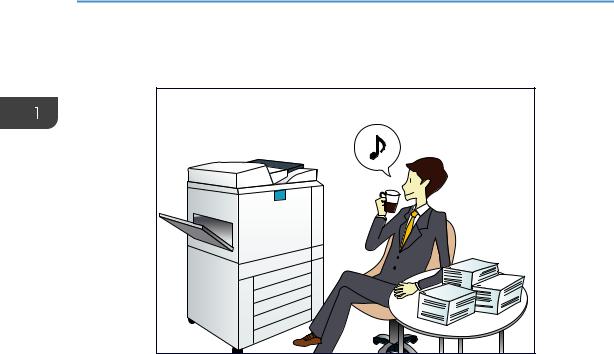
1. What You Can Do with This Machine
Operating the Machine More Effectively
BQX139S |
Registering and using frequently-used settings (Program)
 See "Registering Functions in a Program", Convenient Functions.
See "Registering Functions in a Program", Convenient Functions.
Registering frequently-used settings as initial settings (Program as Defaults (Copier/Document Server/Fax/Scanner))
 See "Changing the Default Functions of the Initial Screen", Convenient Functions.
See "Changing the Default Functions of the Initial Screen", Convenient Functions.
Registering frequently-used printing settings to the printer driver
 See "Using One Click Presets", Print.
See "Using One Click Presets", Print.
Changing the initial settings of the printer driver to frequently-used printing settings
 See "Displaying the Printing Preferences Dialog Box", Print.
See "Displaying the Printing Preferences Dialog Box", Print.
Adding shortcuts to frequently used programs or Web pages
 See "Adding Icons to the [Home] Screen (When Using the Standard Operation Panel)", Convenient Functions.
See "Adding Icons to the [Home] Screen (When Using the Standard Operation Panel)", Convenient Functions.
 See "Adding Icons to the [Home] Screen (When Using the Smart Operation Panel)", Convenient Functions.
See "Adding Icons to the [Home] Screen (When Using the Smart Operation Panel)", Convenient Functions.
Changing the order of the function and shortcut icons
 See "Changing the Order of Icons on the [Home] Screen (When Using the Standard Operation Panel)", Convenient Functions.
See "Changing the Order of Icons on the [Home] Screen (When Using the Standard Operation Panel)", Convenient Functions.
 See "Changing the Order of Icons on the [Home] Screen (When Using the Smart Operation Panel)", Convenient Functions.
See "Changing the Order of Icons on the [Home] Screen (When Using the Smart Operation Panel)", Convenient Functions.
12
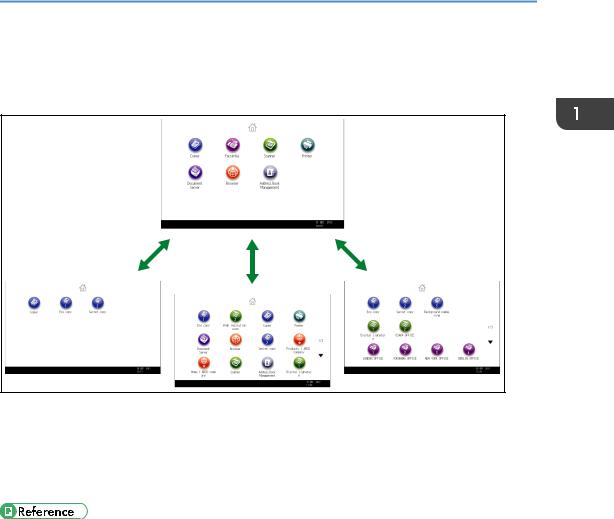
Customizing the [Home] Screen
Customizing the [Home] Screen
The icons of each function are displayed on the [Home] screen.
CUM001
•You can add shortcuts to often used programs or Web pages to the [Home] screen. The programs or Web pages can be recalled easily by pressing the shortcut icons.
•You can display only the icons of functions and shortcuts that you use.
•You can change the order of the function and shortcut icons.
•For details about the features on the [Home] screen, see "How to Use the [Home] Screen (When
Using the Standard Operation Panel)" and "How to Use the [Home] Screen (When Using the Smart
Operation Panel)", Getting Started.
•For details about how to customize the [Home] screen, see "Types of [Home] Screens and How to Customize Them (When Using the Standard Operation Panel)" and "How to Customize the [Home] Screen (When Using the Smart Operation Panel)", Convenient Functions.
13
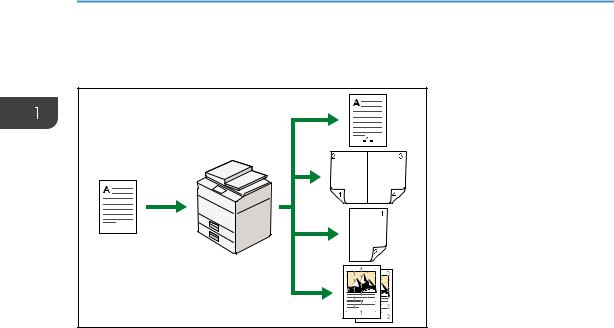
1. What You Can Do with This Machine
Making Copies Using Various Functions
CJQ601 |
•You can make copies in full color. You can switch the color copy mode depending on the type of originals used and the desired finish.
 See "Copying in Color", Copy/ Document Server.
See "Copying in Color", Copy/ Document Server.
•You can print stamps on copies. Stamps can include background numbers, scanned images, dates, and page numbers.
 See "Stamps", Copy/ Document Server.
See "Stamps", Copy/ Document Server.
•You can adjust the color tones and image quality of your copies.
 For details about a color adjustment, see "Adjusting Color", Copy/ Document Server.
For details about a color adjustment, see "Adjusting Color", Copy/ Document Server.
 For details about an image adjustment, see "Image Adjustment", Copy/ Document Server.
For details about an image adjustment, see "Image Adjustment", Copy/ Document Server.
•You can reduce or enlarge the copy image. Auto Reduce / Enlarge function enables the machine to detect the original size automatically. Also, it enables the machine to select an appropriate reproduction ratio based on the paper size you specify. If the orientation of the original is different from that of the paper you are copying onto, the machine rotates the original image by 90 degrees to match it with the copy paper.
 See "Reducing or Enlarging Originals", Copy/ Document Server.
See "Reducing or Enlarging Originals", Copy/ Document Server.
•Copier functions such as Duplex, Combine, Booklet, and Magazine allow you to save on paper by copying multiple pages onto single sheets.
 For details about duplex copying, see "Duplex Copying", Copy/ Document Server.
For details about duplex copying, see "Duplex Copying", Copy/ Document Server.
 For details about combined copying, see "Combined Copying", Copy/ Document Server.
For details about combined copying, see "Combined Copying", Copy/ Document Server.
 For details about combined copying, see "Booklet/Magazine", Copy/ Document Server.
For details about combined copying, see "Booklet/Magazine", Copy/ Document Server.
•You can copy onto various types of paper such as envelopes and OHP transparencies.  See "Copying onto Various Types of Paper", Copy/ Document Server.
See "Copying onto Various Types of Paper", Copy/ Document Server.
14

Making Copies Using Various Functions
•The finisher allows you to sort, staple, and punch holes in your copies.  See "Finishing", Copy/ Document Server.
See "Finishing", Copy/ Document Server.
15
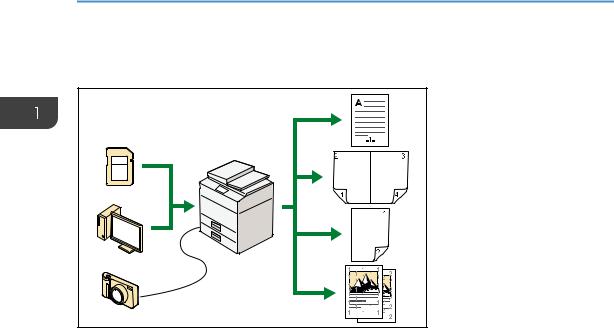
1. What You Can Do with This Machine
Printing Data Using Various Functions
CJQ602 |
•This machine supports network and local connections.
•You can send PDF files directly to the machine for printing, without having to open a PDF application.
 See "Printing a PDF File Directly", Print.
See "Printing a PDF File Directly", Print.
•You can print or delete print jobs stored on the machine's hard disk, which have been previously sent from computers using the printer driver. The following types of print jobs can be selected: Sample Print, Locked Print, Hold Print, and Stored Print.
 See "Storing Documents in the Hard Disk Drive and Printing them", Print.
See "Storing Documents in the Hard Disk Drive and Printing them", Print.
•The finisher allows you to collate, staple, and punch holes in your prints.
 For details about stapling, see "Staple", Print.
For details about stapling, see "Staple", Print.
 For details about punching, see "Punch", Print.
For details about punching, see "Punch", Print.
•If the PictBridge card is installed, you can connect a PictBridge-compatible digital camera to this machine using a USB cable. This allows you to print the photographs stored on the camera using the camera's own interface.
 See "Direct Printing from a Digital Camera (PictBridge)", Print.
See "Direct Printing from a Digital Camera (PictBridge)", Print.
•You can print files stored on a removable memory device and specify print conditions such as print quality and print size.
 See "Direct Printing from a Memory Storage Device", Print.
See "Direct Printing from a Memory Storage Device", Print.
16
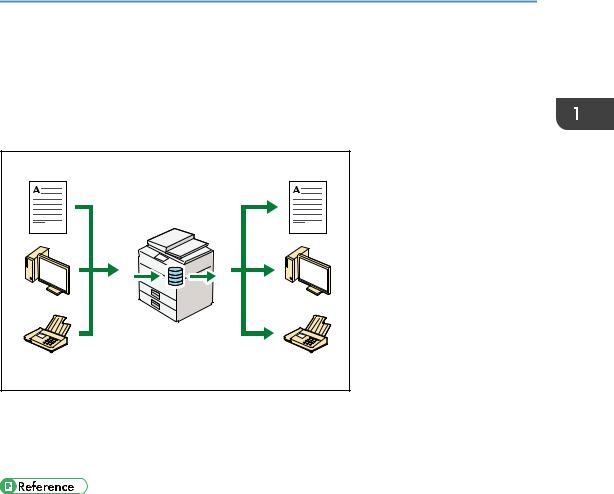
Utilizing Stored Documents
Utilizing Stored Documents
You can store files scanned in copier, facsimile, printer, or scanner mode on the machine's hard disk. Web Image Monitor allows you to use your computer to search for, view, print, delete, and send stored files via the network. You can also change print settings and print multiple documents (Document Server).
CJQ603 |
•You can retrieve stored documents scanned in scanner mode to your computer.
•Using the file format converter, you can download documents stored in copier, Document Server, or printer mode to your computer.
•For details about how to use the Document Server, see "Storing Data in the Document Server", Copy/ Document Server
•For details about the Document Server in copier mode, see "Document Server", Copy/ Document Server.
•For details about the Document Server in printer mode, see "Saving and Printing Using the Document Server", Print.
•For details about the Document Server in fax mode, see "Storing a Document", Fax.
•For details about the Document Server in scanner mode, see "Storing and Saving the Scanned Documents", Scan.
17
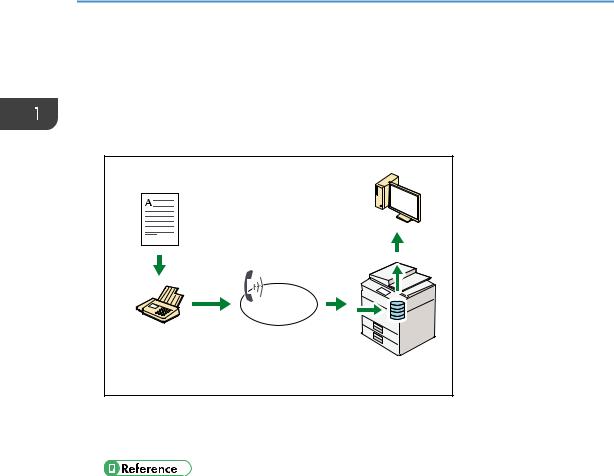
1. What You Can Do with This Machine
Sending and Receiving Faxes without Paper
Reception
You can store and save received fax documents as electronic formats in the machine's hard disk without printing them.
CJQ604
You can use Web Image Monitor to check, print, delete, retrieve, or download documents using your computer (Storing received documents).
• See "Confirming/Printing/Deleting Received and Stored Documents", Fax.
Transmission
You can send a fax from your computer over the network (Ethernet or wireless LAN) to this machine, which then forwards the fax via its telephone connection (LAN-Fax).
18
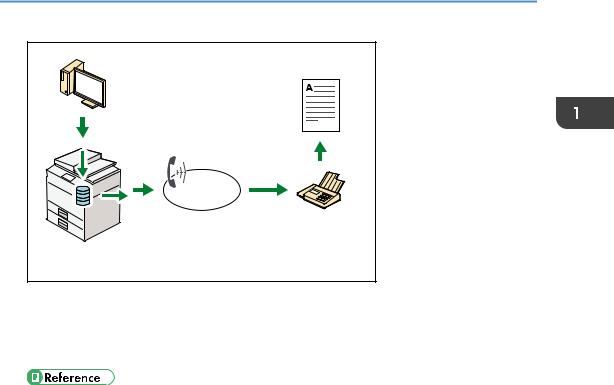
Sending and Receiving Faxes without Paper
CJQ605
•To send a fax, print from the Windows application you are working with, select LAN-Fax as the printer, and then specify the destination.
•You can also check the sent image data.
•For details about the machine's settings, see "Network Settings Requirements", Connecting the Machine/ System Settings.
•For details about how to use the function, see "Sending Fax Documents from Computers", Fax.
19
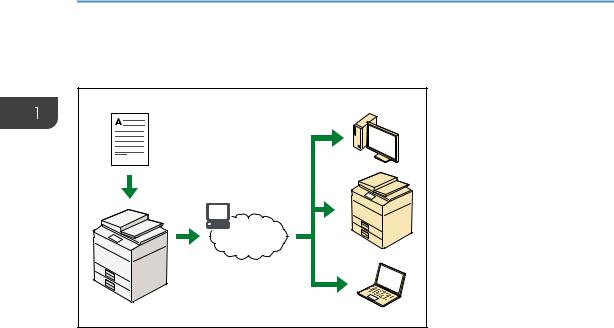
1. What You Can Do with This Machine
Sending and Receiving Faxes via the Internet
xxx@xxx.com
xxx.xxx.xxx.xxx
xxx@xxx.com
xxx.xxx.xxx.xxx
CJQ606
E-mail Transmission and Reception
This machine converts scanned document images to e-mail format, and transmits and receives the e-mail data over the Internet.
•To send a document, specify an e-mail address instead of dialing the destination telephone number (Internet Fax and e-mail transmission).
 See "Specifying an Internet Fax Destination by Entering It Manually", Fax.
See "Specifying an Internet Fax Destination by Entering It Manually", Fax.
•This machine can receive e-mail messages via Internet Fax or from computers (Internet Fax Reception and Mail to Print).
 See "Receiving E-mail by Internet Fax/Mail to Print", Fax
See "Receiving E-mail by Internet Fax/Mail to Print", Fax
•Internet Fax compatible machines and computers that have e-mail addresses can receive e- mail messages via Internet Fax.
IP-Fax
The IP-Fax function sends or receives documents between two facsimiles directly via a TCP/IP network.
•To send a document, specify an IP address or host name instead of a fax number (IP-Fax Transmission).
 See "Specifying an IP-Fax Destination by Entering It Manually", Fax.
See "Specifying an IP-Fax Destination by Entering It Manually", Fax.
•This machine can receive documents sent via Internet Fax (IP-Fax Reception).  See "Types of Reception", Fax.
See "Types of Reception", Fax.
•Using a VoIP gateway, this machine can send to G3 facsimiles connected to the public switched telephone network (PSTN).
20

Sending and Receiving Faxes via the Internet
•For details about the machine's settings, see "Network Settings Requirements", Connecting the Machine/ System Settings.
21
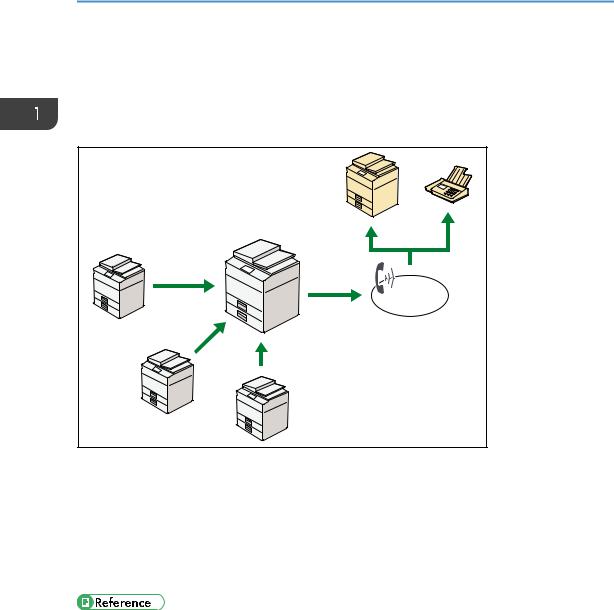
1. What You Can Do with This Machine
Sending and Receiving Faxes by Using the Machine without Fax Unit Installed
You can send and receive faxes through a different machine's fax functions via a network (Remote Fax).
CJQ612 |
•To use the remote fax function, install the fax connection unit on the main-machine and submachine.
•The procedure for sending faxes is as same as that of for the machine with the fax unit. When a job has finished, confirm results displayed on sending history or printed on reports.
•You can forward documents received by the main machine with the facsimile function to submachines.
•For details, see "Sending/Receiving Documents Using a Remote Machine (Remote Fax)", Fax.
22
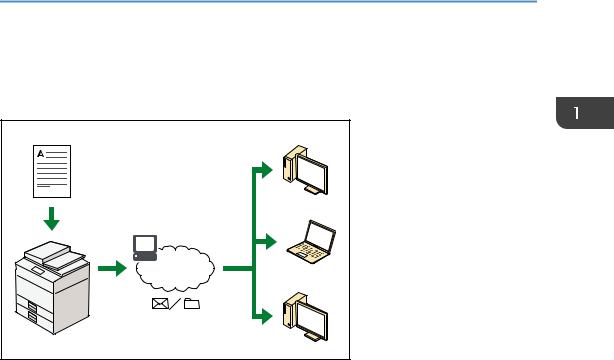
Using the Facsimile and the Scanner in a Network Environment
Using the Facsimile and the Scanner in a
Network Environment
CJQ607 |
•You can send scan files to a specified destination using e-mail (Sending scan files by e-mail).  See "Overview of E-mail Transmission Function", Fax.
See "Overview of E-mail Transmission Function", Fax.
 See "Basic Procedure for Sending Scan Files by E-mail", Scan.
See "Basic Procedure for Sending Scan Files by E-mail", Scan.
•You can send scan files directly to folders (Sending scan files by Scan to Folder).  See "Overview of Folder Transmission Function", Fax.
See "Overview of Folder Transmission Function", Fax.
 See "Basic Procedure When Using Scan to Folder", Scan.
See "Basic Procedure When Using Scan to Folder", Scan.
•You can use this machine as a delivery scanner for the ScanRouter delivery software*1 (Network delivery scanner). You can save scan files in the delivery server or send them to a folder in a computer on the same network.
 See "Basic Procedure for Delivering Files", Scan.
See "Basic Procedure for Delivering Files", Scan.
•You can use Web Services on Devices (WSD) to send scan files to a client computer.
 See "Basic Operating Procedure of WSD Scanner (Push Type)", Scan.
See "Basic Operating Procedure of WSD Scanner (Push Type)", Scan.
*1 The ScanRouter delivery software is no longer available for sale.
23
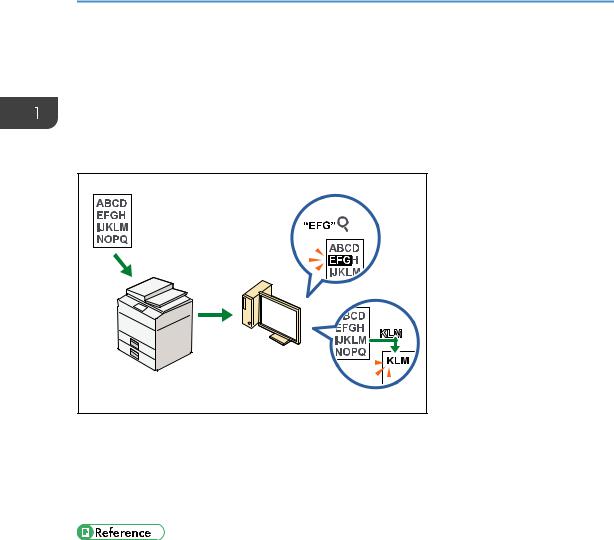
1. What You Can Do with This Machine
Embedding Text Information in Scanned Files
You can extract text information from a scanned document and embed it in the file without using a computer.
If you scan a document using this function, embedded text can be searched by using the text search function or copied to another document.
CUL003 |
•To use this function, the optional OCR unit is required.
•You can select a file type from [PDF], [High Compression PDF], or [PDF/A].
•This function can optically recognize characters in various languages and up to approximately 40,000 characters a page.
•See "Embedding Text Information in Scanned Data", Scan.
24
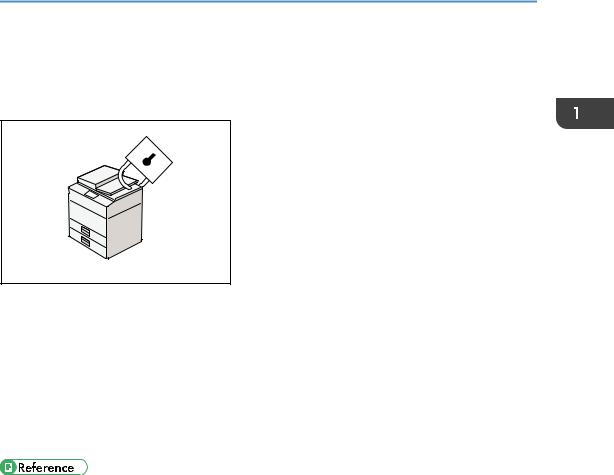
Preventing Information Leakage (Security Functions)
Preventing Information Leakage (Security
Functions)
CJQ608
•You can protect documents from unauthorized access and stop them from being copied without permission.
•You can control the use of the machine, as well as prevent machine settings from being changed without authorization.
•By setting passwords, you can prevent unauthorized access via the network.
•You can erase or encrypt the data on the hard disk to minimize the risk of information leakage.
•You can limit the usage of functions for each user.
•See Security Guide.
25
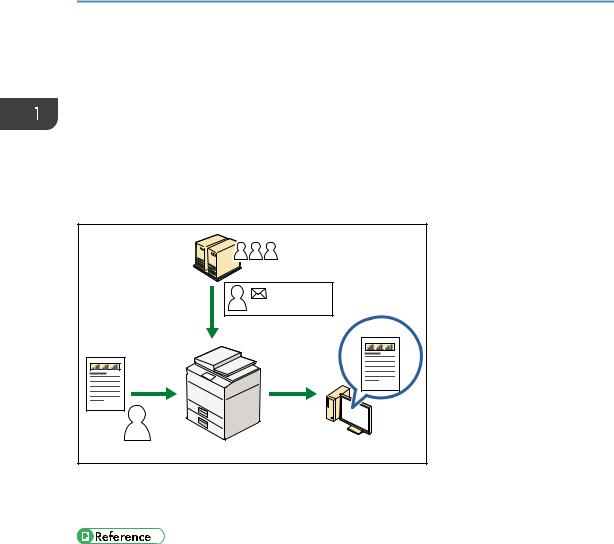
1. What You Can Do with This Machine
Centrally Controlling Scan Conditions and
Distribution
You can use the distributed scan management (DSM) system in Windows Server 2008 R2 to manage the destinations and scan settings for each individual user in a group and to use the information when distributing scanned data.
You can also use this system to centrally manage information about people using the network and the machine's scanner functions. Both delivered files and user information can be controlled.
A |
xxx@xxx.xxx |
600 dpi |
|
|
600 dpi |
A |
xxx@xxx.xxx |
|
|
|
CUL004 |
•You must set up and configure a Windows server to use the distributed scan management system. This system is supported under Windows Server 2008 R2.
•For details about how to deliver files using the distributed scan management system, see "Managing Scan Conditions and Other Settings in the Block using Distributed Scan Management", Scan.
26
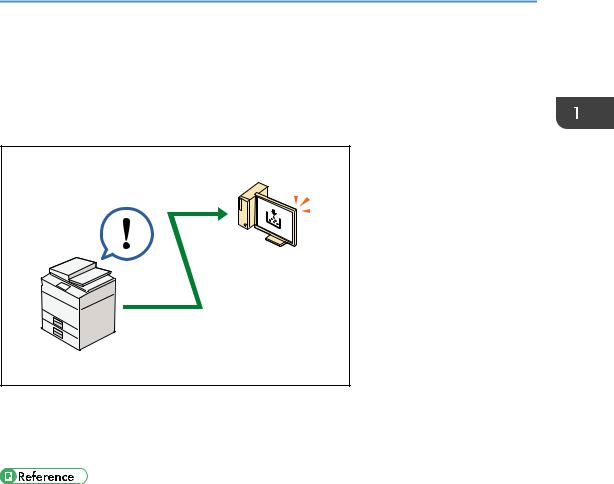
Monitoring and Setting the Machine Using a Computer
Monitoring and Setting the Machine Using a
Computer
Using Web Image Monitor, you can check the machine's status and change the settings.
CJQ609
You can check which tray is running out of paper, register information in the Address Book, specify the network settings, configure and change the system settings, manage jobs, print the job history, and configure the authentication settings.
•See "Using Web Image Monitor", Connecting the Machine/ System Settings.
•See Web Image Monitor Help.
27
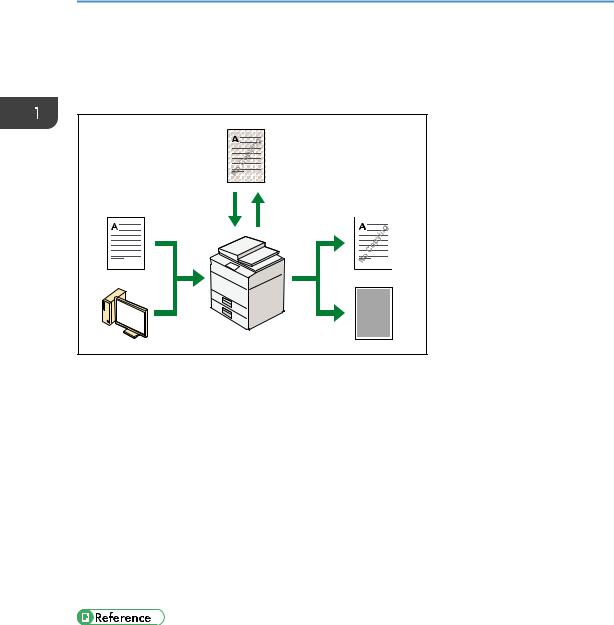
1. What You Can Do with This Machine
Preventing Unauthorized Copying
You can print embedded patterns on printouts to prevent unauthorized copying.
CUM003 |
•Using the copier function or the printer driver, you can embed a pattern in the printed document. If the document is copied on a machine with the Copy Data Security unit, protected pages are grayed out in the copy. This can minimize the risk of confidential information being copied. Protected fax messages are grayed out before being transmitted or stored. If a document protected by unauthorized copy guard is copied on a machine that is equipped with the Copy Data Security unit, the machine beeps to notify users that unauthorized copying is being attempted.
If the document is copied on a machine without the Copy Data Security Unit, the hidden text becomes conspicuous in the copy, showing that the copy is unauthorized.
•Using the copier function or the printer driver, you can embed text in the printed document for unauthorized copy prevention. If the document is copied, scanned, or stored in a Document Server by a copier or multifunction printer, the embedded text appears conspicuous in the copy, discouraging such unauthorized copying.
•For details, see the printer driver Help and Security Guide.
•For details about this function in the copier mode, see "Preventing Unauthorized Copies", Copier/ Document Server.
•For details about this function in the printer mode, see "Printing Documents that Are Not Authorized for Duplication", Print.
28
